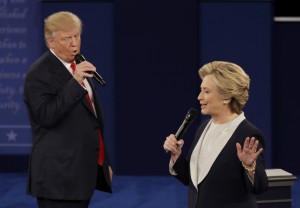 The consequences of the presidential election on national policy are becoming clearer each day, as Trump appoints deeply anti-government people to run major agencies, from education to labor to the EPA. Progressive groups will likely be on defense for the next four or more years, putting our country’s ability to remain an international leader on issues like the environment in jeopardy.
The consequences of the presidential election on national policy are becoming clearer each day, as Trump appoints deeply anti-government people to run major agencies, from education to labor to the EPA. Progressive groups will likely be on defense for the next four or more years, putting our country’s ability to remain an international leader on issues like the environment in jeopardy.
With that in mind, it’s worth looking back at the campaign that put the country in this situation. Politico has a fascinating piece on the 10 big decision points that shaped the race, culled from interviews with key players over the 18-month campaign. The points range Clinton and Trump’s decisions to run, to some of the big moments, like Sanders not attacking Clinton on emails and the FBI director’s last-minute letter on Clinton’s emails.
It’s a long piece, but here is probably the key passage:
But, in the end, Brooklyn [Clinton campaign headquarters] simply failed to predict the tidal wave that swamped Clinton—a pro-Trump uprising in rural and exurban white America that wasn’t reflected in the polls—and his candidate failed to generate enough enthusiasm to compensate with big turnouts in Detroit, Milwaukee and the Philadelphia suburbs.
Either way, there was something missing that technocrats couldn’t fix: The candidate herself was deeply unappealing to the most fired-up, unpredictable and angry segment of the electorate—middle-income whites in the Middle West—and she couldn’t inspire Obama-like passion among her own supporters to compensate for the surge.
The piece also goes through Trump’s relationship with the media and how he honed his strategy, with rallies that allowed him to test his messaging and develop material like a stand-up comedian on the road.
I was particularly struck at how a demagogue-style, populist message of darkness resonated in this country, even in his post-convention attack on a Gold Star family (the Khans):
“If he loses,” Robby Mook, Clinton’s campaign manager, told me at the time, “his attack on Khans was the turning point.”
But here’s the thing: At that very moment, Mook’s own internal data was showing that Trump’s negative message overall—his “diagnosis of the problem” as Brooklyn called it—was resonating.
Clinton’s team laughed off Trump’s nomination speech. Yet her pollster John Anzalone and his team were stunned to find out that dial groups of swing state voters monitored during the speech “spiked” the darker the GOP nominee got, according to a staffer privy to the data.
The article also criticizes Clinton’s decision to essentially take time off in August and let Trump come back, as well as her decision not to campaign more in the rust belt, which was always touted as Trump’s only path to victory:
Jake Sullivan, Clinton’s policy director—a brainy and nervous former State Department aide who took on an increasingly important political role as the campaign ground on—was the only one in Clinton’s inner circle who kept saying she would likely lose, despite the sanguine polling, according to his friends. He was also the only one of the dozen aides who dialed in for Clinton’s daily scheduling call who kept on asking if it wasn’t a good idea for her to spend more time in the Midwestern swing states in the closing days of the campaign.
His suggestion wasn’t rejected; it never got that far because nobody else on the call thought it was a good idea. They spent far more time debating whether or not Clinton should visit Texas and Arizona, two states they knew she had little chance of winning, in order to get good press.
There are other good post-mortems on the election out there, particularly David Roberts’ recent piece at Vox, and political junkies could spend hours reading and debating.
But as the analysis settles, we’ll have to address the consequences of this election on national policy. And given the direction so far (to say nothing of the campaign trail rhetoric), they’re likely to be massive.
Leave a Reply
You must be logged in to post a comment.


